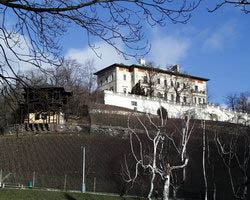
Gröbeho villa in Prague opens to the public
 |
"It is a cultural monument. The influence and opinion of conservationists were limiting during the reconstruction," said project manager František Mareš to reporters today. "Conservationists watch over their elements and period features, mainly in the ground floor and the first floor or façade," he added. In the other floors and basement, the designers had more freedom. They tried to sensitively incorporate modern windows and lighting, for example. However, conservationists also monitored elements such as the doors and parquet flooring used there. "It must somehow harmonize with what was found in the villa," Mareš pointed out. Period documentation was also used during the reconstruction.
In the first floor, the main work was done by restorers who restored the original stucco ceilings. The one over the staircase still bears the mark of the pioneers who resided in the villa. In its center is a hammer and sickle. "This is at the request of the conservationists. After fifty years, everything essentially becomes an artifact," Mareš explained.
The outdoor façades with sgraffito have also been restored. Under the roof, a band of frescoes with child motifs decorates the villa, while plant friezes adorn the walls. The ground floor of the villa features a spacious terrace connected by a two-flight staircase to the vineyard. "There are beautiful views of Vršovice and Pankrác. Too bad it's not a more attractive place. Mr. Gröbe knew where to build," Mareš said.
The villa will house libraries, conference halls, and training spaces. The basement will serve as accommodation for students. They will also have access to a kitchen and a spacious dining room, which houses the foundation stone laid by Moritz Gröbe. Most rooms are still not furnished.
The renovation, costing approximately 200 million crowns, was paid for by the Ceeli Institute. The city council of the second district contributed an additional 12.6 million for the reconstruction of Havlíčkovy Sady. The institute is also renovating the lower Landhauska, which will provide residential space for trainers. The company obtains funding from government grants, foundations, or contributions from private companies.
The training center focuses on lawyers from countries transitioning from undemocratic systems to market economies. In addition to Central and Eastern Europe, lawyers from Africa and the Middle East also visit Prague. "Our institute aims to contribute through lectures and seminars to reforms in these countries," said Simona Trázníková from the institute. Reformers are trained by experts from various countries, including the Czech Republic. They are not paid for lecturing, and participants do not pay any fees for the training.
The villa in the Italian Renaissance style was built between 1871 and 1888 as a summer residence for industrialist Moritz Gröbe. The project was designed by Antonín Barvitius, and the interiors were designed by Josef Schulz. In 1905, the villa and the surrounding buildings were purchased by the Vinohrady municipality. Bombing in the winter of 1945 and a subsequent fire significantly damaged the structure. It was repaired seven years later and served as a House of Pioneers and Youth. Since 2003, the Ceeli Institute has been reconstructing the building. It has leased it from the city district for 50 years.
The Prague 2 municipality also plans to restore the pavilion in Havlíčkovy Sady. The old part, which previously housed a bowling alley and shooting range, should remain dominant. A café or pastry shop is planned to be established in the new section. The pond will also be renovated. The council is considering cultural uses for the artificial cave, where open-air performances should take place. The city district has so far managed to restore the Vines Pavilion, the stone wall, and the entrance gates in the park.
The English translation is powered by AI tool. Switch to Czech to view the original text source.
0 comments
add comment






